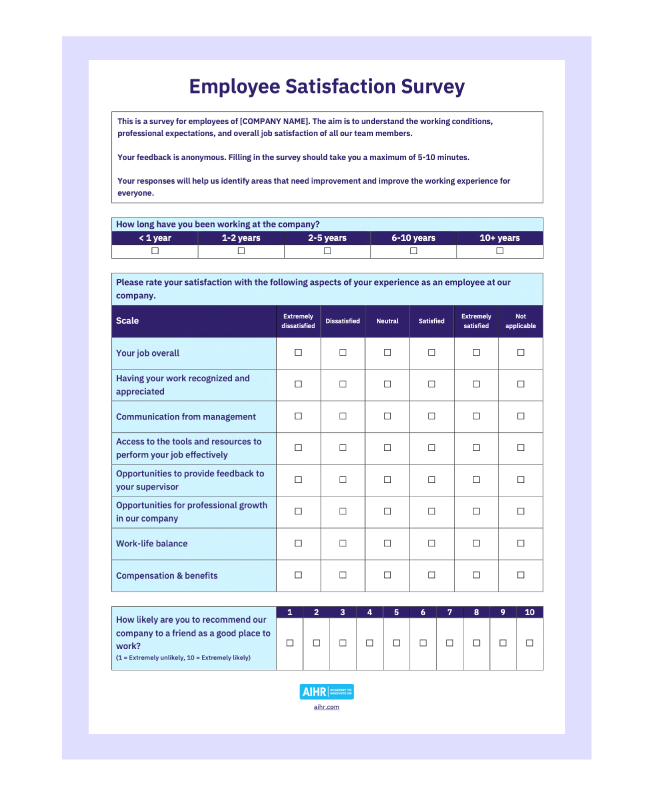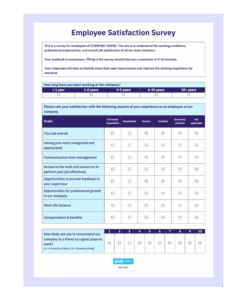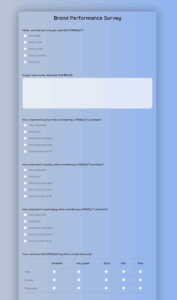Ever wondered how to truly gauge the pulse of your workforce? It’s more than just a gut feeling; understanding what makes your employees tick, what challenges they face, and what truly satisfies them is paramount for a thriving workplace. Happy employees are often more productive, more engaged, and far less likely to seek opportunities elsewhere. This isn’t just about morale; it directly impacts your bottom line, fostering a culture of innovation and loyalty.

But how do you gather this valuable insight effectively and systematically? That’s where a well-designed employee satisfaction survey comes into play. It provides a structured way to collect honest feedback, identify areas for improvement, and celebrate what’s working well within your organization. The good news is you don’t have to start from scratch; a robust sample employee satisfaction survey template can give you an excellent foundation to begin your journey toward a happier, more productive team.
Why a Thoughtful Survey is Your Best Ally
Collecting feedback from your employees isn’t just a tick-box exercise; it’s a strategic move that strengthens your entire organization. When employees feel heard, they feel valued, and that translates into greater commitment and enthusiasm for their work. A carefully designed survey allows you to uncover hidden issues before they escalate, address frustrations, and pinpoint opportunities for growth and development within your company culture.
Think about it: an employee might be quietly struggling with workload, a lack of clarity in their role, or feeling disconnected from the company’s vision. Without an anonymous and accessible channel like a survey, these concerns might never reach management, slowly eroding morale and productivity. A survey acts as a direct line, providing a safe space for honest opinions that might otherwise remain unspoken.
Beyond identifying problems, surveys also highlight your strengths. You might discover that your team truly appreciates your flexible work policy or the professional development opportunities you offer. Knowing what’s going well allows you to double down on those successful initiatives, using them as benchmarks for other areas and reinforcing a positive environment. It’s a two-way street that builds trust and transparency.
The right questions in your sample employee satisfaction survey template can unlock a wealth of information that can guide your HR strategies, management training, and even long-term business planning. It’s about proactive management, not just reactive problem-solving.
Key Areas to Cover in Your Survey
To ensure your survey is comprehensive and provides actionable insights, consider including questions that touch upon various aspects of the employee experience. A good sample employee satisfaction survey template often includes sections for:
- Overall Satisfaction: General happiness with their job, team, and company.
- Job Role and Responsibilities: Clarity of duties, workload management, and opportunities for growth.
- Management and Leadership: Effectiveness of supervisors, communication, and support.
- Work Environment: Physical workspace, team dynamics, and company culture.
- Compensation and Benefits: Perception of fairness, adequacy, and understanding of offerings.
- Professional Development: Opportunities for training, skill enhancement, and career advancement.
- Work-Life Balance: Ability to manage personal and professional commitments.
- Company Vision and Values: Alignment with organizational goals and mission.
Crafting Your Own Effective Survey
While a sample employee satisfaction survey template provides a fantastic starting point, tailoring it to your specific organizational context is crucial. Every company has its unique culture, challenges, and strengths. Customizing the questions ensures that the feedback you receive is relevant and directly applicable to your current situation, making the results far more valuable for decision-making.
When adapting a template or building your own survey, focus on clarity and conciseness in your questions. Use simple, direct language to avoid ambiguity, and ensure that questions are not leading. Offering a mix of rating scales (e.g., 1-5, strongly agree to strongly disagree) and open-ended text boxes allows for both quantitative data analysis and qualitative insights, giving you a richer understanding of employee sentiment.
Remember to emphasize anonymity. Assuring employees that their responses are confidential is key to encouraging honest and candid feedback. If employees fear repercussions, they are less likely to share their true feelings, rendering the survey results inaccurate. Clearly communicate how the data will be used and that individual responses will not be attributed back to them.
Finally, don’t just collect data and let it sit. The most critical step after distributing your sample employee satisfaction survey template and gathering responses is to act on the feedback. Share a summary of the findings with your employees, highlight key areas for improvement, and outline specific actions your company plans to take. This demonstrates that their voices truly matter and fosters a culture of continuous improvement and trust. Ignoring feedback can be more detrimental than not surveying at all, as it can lead to cynicism and disengagement.
By regularly conducting these surveys and consistently demonstrating a commitment to addressing the insights gained, you are not just measuring satisfaction; you are actively cultivating a workplace where employees feel valued, heard, and motivated. This proactive approach leads to a more positive, productive, and stable workforce, benefiting everyone involved in the long run.
Ultimately, investing time and effort into understanding your employees’ perspectives is one of the smartest decisions any organization can make. It transforms potential problems into opportunities for growth and strengthens the foundation of your company from within, building a loyal and high-performing team.


